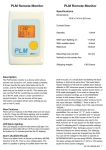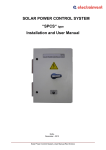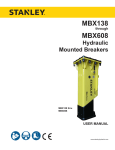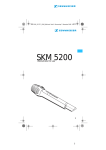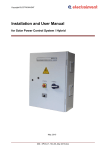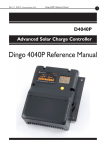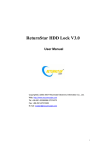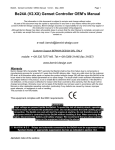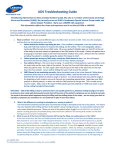Download PVES User Manual-4.10
Transcript
PVES Series User Manual User Manual Shenzhen Pvinergy Technologies Co., Ltd PVES Series Solar Residential System PVES Series User Manual Overview Thank you for choosing PVES series solar residential system from Shenzhen Pvinergy Technologies Co., Ltd. With the innovative design and impeccable quality control, PVES series solar residential system has extremely high stability and reliability, which are widely applied for high-demanding solar off-grid system. This manual describes the installation, operation and troubleshooting of PVES series. Please read this manual carefully before installations and operations. If any problem is encountered during installation or operation, please refer to the manual before contacting the local distributor or sales representative. This manual could be helpful to solve most difficulties of installation and operation. If necessary, please contact installers. Shenzhen Pvinergy Technologies Co., Ltd Room 12A08, Elite building, Nanshan Rd., Nanshan District, Shenzhen, China. Postal Code:518054 Tel:+86 0755 2394 3401 Fax:+86 0755 827 12814 Web:http://www.pvinergy.com PVES Series User Manual Contents 1. Symbol Explanation ................................................................................................................................. - 1 - 2. Product Introduction .................................................................................................................................... - 2 2.1 PVES Appearance Overview .................................................................................................................... - 2 2.2 Dimensions and Weights .......................................................................................................................... - 3 2.3 System Diagram ....................................................................................................................................... - 4 3. Installation..................................................................................................................................................... - 4 3.1 Notes before Installation........................................................................................................................... - 4 3.2 Checklist of Package ................................................................................................................................ - 4 3.3 Safety Precautions .................................................................................................................................... - 5 4. Circuit Connection ....................................................................................................................................... - 5 4.1 Input and Output Terminals ...................................................................................................................... - 5 4.2 Wiring Diagram under Inverter Mode ...................................................................................................... - 6 4.3 Wiring Diagram under Charging Inverter Mode ...................................................................................... - 6 5. PVES Operation Instruction ....................................................................................................................... - 7 5.1 Inverter Mode ........................................................................................................................................... - 7 5.2 Charing Inverter Mode ............................................................................................................................. - 7 6. HMI Instruction............................................................................................................................................ - 7 6.1 LCD Display ........................................................................................................................................... - 7 7. Alarm Information and Troubleshooting ................................................................................................... - 8 7.1 System Failure ......................................................................................................................................... - 9 8. Technical Data ..............................................................................................................................................- 11 - PVES Series User Manual 1. Symbol Explanation Danger High‐voltage risk; Inhibit touching; if not avoided, there will result in casualties. Warning Potential risk; if not avoided, there will result in casualties. Warning High temperature; inhibit touching; incaution touching may result in scald. Attention Attention to existing potential risk; if not avoided, could cause the device not operating properly or property loss. Attention It is compliance with WEEE directive. -1- Installation and User Manual PVES Series User Manual 2. Product Introduction 2.1 PVES Appearance Overview -2- Installation and User Manual PVES Series User Manual 2.2 Dimensions and Weights Model Width(mm) Depth(mm) Length(mm) Weight(Kg) PVES300 255 305 143 5.5 PVES600 255 305 143 5.7 PVES800 255 305 143 5.7 PVES1000 285 335 143 6.0 -3- Installation and User Manual PVES Series User Manual 2.3 System Diagram A. B. C. D. Solar Panel: Provide DC power to inverter PVES Inverter: Charging battery via DC power from solar panel(s); Converting DC power from battery to 110/220V AC power for loads; Providing 12V/24V and 5V DC input Battery: Charging through controller, storing solar energy and discharging to loads Loads: Divided into AC loads and DC loads, such as fan, TV, computer, light, mobile phone, etc 3. Installation 3.1 Notes before Installation Ÿ Ÿ Ÿ Ÿ Ÿ Ÿ This user manual describes inverter installation and safety operation. Please follow below instructions carefully before installation: To check the ambient temperature for installation, it is recommended from 0℃ to 45℃ AC output voltage range: 110/220Vac±5%, 50/60Hz Adequate convection space surrounds the inverter The inverter is installed far away from explosive vapor No flammables are near the inverter Do not expose the PV inverter to direct sunlight 3.2 Checklist of Package Please go over the items carefully in the box after open the package. The items should contain as below: No. Items Quantity -4- Installation and User Manual PVES Series User Manual 1 PVES300/PVES600/PVES800/PVES1000 inverter 1 2 12/24V incandescent light with wires 1 2 3 Length: 1m 6 mm cable and battery clamp 1 4 User Manual 1 5 Quality Assurance Card 1 6 10 in one USB cable 1 Verify that the above items are complete when open the package 3.3 Safety Precautions A. B. C. D. E. Do not disassemble the enclosure. This inverter does not contain user serviceable parts. Refer all servicing to qualified service personnel. All wiring and electrical installation should be conducted by the qualified service personnel and must meet CE requirements. AC loads, PV voltage and Bat voltage are terminated inside the PV Inverter. Please disconnect these circuits before servicing. Energy stored in this equipment’s DC link capacitors presents a risk of electric shock. Even if the equipment is disconnected from the grid and photovoltaic panels, high voltages may still exist inside the PV inverter. Do not disassemble the enclosure until at least 5 minutes after disconnecting all power sources. This inverter is mainly designed for 110/220V AC loads, 12V/24V and 5V DC loads. Please do not connect the inverter to grid, otherwise serious damage will be resulted in to the equipment. Attentively take the inverter out from its packaging and inspect for external damage. If any flaw is found, please contact the local dealers. 4. Circuit Connection 4.1 Input and Output Terminals Terminal symbols Function instruction Quantity Bat+ Battery anode terminal 1 Bat- Battery cathode terminal 1 PV+ PV panel anode terminal 1 PV- PV panel cathode terminal 1 -5- Installation and User Manual PVES Series User Manual Terminal symbols Function instruction Quantity Power Electric switch for inverter 1 AC Switch Output switch for 110/220V AC inverter 1 DC Switch 12V/24V and 5V DC output switch 1 DC 5V 5V DC output terminal, USB connection 2 DC 12V/24V 12V/24V DC output terminal 4 4.2 Wiring Diagram under Inverter Mode A. Please avoid short-circuit for battery and make sure the polarity is correct before battery connects to the unit. Incorrect polarity connection could cause permanently damage of the unit. B. The cathode and anode terminal of battery are connected respectively to the Bat+ and Batterminal of off-grid inverter. Each DC terminal on the inverter can tolerate 100ADC. The suggested connect wire for positive (+) is red wire, and for negative (-) is black wire. -6- Installation and User Manual PVES Series User Manual 4.3 Wiring Diagram under Charging Inverter Mode A. Before connecting PV panels to PV terminals, please make sure the polarity is correct. Please avoid short-circuit for battery and make sure the polarity is correct before battery connects to the unit. Incorrect polarity connection could cause permanently damage of the unit. B. The cathode and anode terminal of PV panels are connected respectively to the PV+ and PVterminal of off-grid inverter. Each DC terminal on the inverter can tolerate 50ADC. The suggested connect wire for positive (+) is red wire, and for negative (-) is black wire. C. The cathode and anode terminal of battery are connected respectively to the Bat+ and Batterminal of off-grid inverter. Each DC terminal on the inverter can tolerate 100ADC. The suggested connect wire for positive (+) is red wire, and for negative (-) is black wire. 5. PVES Operation Instruction PVES series solar residential system can not only under charging inverter mode, but also inverter mode. 5.1 Inverter Mode A. B. C. D. Connect battery wires pursuant to figure 4.2, the wiring diagram Power switch: Turn the switch on the back of power into on AC output switch: connect to AC switch, providing 110/220V and 50/60Hz AC power to loads DC output switch: connect to DC output switch, providing DC output with 12V/24V and 5V 5.2 Charging Inverter Mode A. B. C. D. Connect the PV and BAT cables pursuant to figure 4.2, the wiring diagram Power switch: Turn the switch on the back of power into on, providing power for battery by controller AC output switch: connect to AC switch, providing 110/220V and 50/60Hz AC power to loads DC output switch: connect to DC output switch, providing DC output with 12V/24V and 5V Notes: It is extremely easy to operate the PVES solar residential system. The machine -7- Installation and User Manual PVES Series User Manual works automatically when it is at normal charging. If it needs to support loads, AC Switch and DC Switch should be operated manually. Besides, in order to achieve maximum conversion efficiency for inverter, please read below information carefully: A. Charging mode: inverter is going on three phase charging automatically when it is at normal charging B. Adjustment for LCD backlight: for power saving, the LCD backlight will be closed automatically after 20 seconds C. Standby mode: in order to save power for battery, it is recommended to turn off AC switch and DC switch 6. HMI Instruction 6.1 LCD Display There are 2 LED indicating lights and 1 button in HMI as below: Contents Function instruction Red light(Fault) ü Fault when red light is on Green light(Run) ü Run when green light is on Button(Info) ü Press the button and LCD backlight is on ü Pv Volt ü PV panels voltage ü Bat Volt ü Battery voltage What LCD displays ü Chg Cur ü Battery charging current when system runs ü Out Volt ü AC output voltage ü Out Cur ü AC output current ü Out Power ü Output power -8- Installation and User Manual PVES Series User Manual Contents What LCD displays Function instruction Refer to figure 7.1 for Refer to figure 7.1 for system failure when system fails system failure 7. Alarm Information and Troubleshooting PVES series solar residential system has a perfectly complete alarm and protection function. When system fails, controller can clearly indicate the fault and alarm. Red light is on and alarmed, and LCD displays what the fault is. Pursuant to the LCD, fault can be rapidly recognized so that relevant strategy is made to solve it. 7.1 System Failure System Failure Reasons Strategies 1. Check the connection for loads 2. Check whether the power of load exceeds rated output power 3. Please call local service 1. Replace a new fan 2. Dredge the air inlet and outlet 3. Please call local service ü AC Fault Over current 1. Short-circuit for output load 2. Over-load ü AC Fault high temp 1. Fan is failed to work 2. There are too much dust or block in air inlet or outlet ü AC Fault low temp 1.Put the system on high temperature 2.Please call local service ü DC Fault bat low volt 1. Environment temperature is low 2.No connection for temperature sensor 1.The power of battery is low ü DC Fault bat high volt 1.Over-charge for battery 2.False series number battery 1. Turn off the DC switch and reboot 2. Check series number for battery AC Fault out high volt 1. High-voltage for AC output ü for 1.Charge the battery 2.Please call local service 1.Please call local service -9- Installation and User Manual PVES Series User Manual System Failure ü AC Fault Reasons Strategies 1. Low-voltage for AC output 1.Please call local service 1. Booster circuit fault 1.Please call local service out low volt ü AC Fault bus high ü AC Fault bus low ü AC Fault out over load ü DC Fault pv high volt ü DC Fault load oc ü DC Fault 1.Please call local service 2.Check whether the power of battery is enough 1. Lower the power of load to rated output power or less 2. Please call local service 1. High-voltage for PV panels 1. Open circuit for PV panels exceeds its specification 2. Please call local service 1. The power of DC 12V/24V 1. Reduce DC loads and 5V loads is higher than 2. Please call local service their rated power 1. Charging circuit fault 1. Please call local service 1.Booster circuit fault 2.The voltage for battery discharges 10.5/20V 1. Over-load Charge over current ü DC Fault Communication off line ü AC Fault Short oc 1.Communcation fault 2.No connection for communication cable 1.short-circuit for out laod 2.Over laod 1. Please call local service 1.Check the connection for laods 2.Check whether the power of laod exceeds Rated output power 3. Please call local service - 10 - Installation and User Manual PVES Series User Manual 8. Technical Data Model Technical data PVES300 PVES600 PVES800 PVES1000 Output data Output voltage 110/220V±5% 110/220V±5% 110/220V±5% 110/220V±5% Output power 300W 600W 800W 1000W Surge capacity 600W 1200W 1600W 2000W >85% >85% >85% >85% Over-load protection Yes Yes Yes Yes Short-circuit protection Yes Yes Yes Yes Pure Sine Wave Pure Sine Wave Pure Sine Wave Pure Sine Wave USB output 5V /2A 5V /2A 5V /2A 5V /2A DC output 12V/8A 24V/8A 24V/8A 24V/8A 18V 120W 32V 250W 32V 250W 32V 250W*2 12V 24V 24V 24V 13.6V 27.2V 27.2V 27.2V 14.4V 28.8V 28.8V 28.8V 25V 60V 60V 60V 10A 10A/20A 20A 20A/30A 0.9W 0.9W 0.9W 0.9W Efficiency Waveform DC outpu t Input data PV panel Battery voltage Floating charge Battery voltage Over-charged protection voltage Max. Voc PV Max. charging controll current er Standby power consumption Environment Working temperature range 0℃ ~ +45℃ Storage temperature range -15℃ ~ +65℃ ≤2000m 79.5kPa~ 106kPa Altitude Relative humidity Non-solidification, relative humidity<90% Mechanical Width/ Depth/ Height (mm) Weight 255/305/143 255/305/143 285/335/143 285/335/143 5.5KG 5.7KG 6.0KG 6.2KG CE Standard - 11 - Installation and User Manual
















